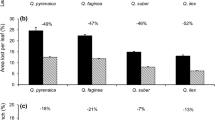Abstract
We examined how acceptability characteristics displayed by 28-day-old seedlings of 12 species of Western Australian Proteaceae affect the likelihood of seedling herbivory in the field. The seedling attributes quantified were cotyledon phenolic, cyanide and nitrogen concentrations, and cotyledon area, thickness and specific leaf area. Only phenolic content was significantly correlated (negatively) with field rates of herbivore attack. This finding shows that the phenomenon of selective herbivore attack on seedlings may be influenced by a specific plant life-history trait, (in this case cotyledon phenolic concentration). In addition, we also studied the interaction between fire, serotiny and herbivory in matched burned and unburned plots. Although herbivore activity was greater in unburned plots, weakly serotinous species were as prone to defoliation as congeneric, strongly serotinous species, even though their seedlings recruit successfully in the absence of fire. This result suggests that seedlings of species able to establish between fires are not better defended against the higher levels of herbivory normally associated with unburned vegetation.
Similar content being viewed by others
Author information
Authors and Affiliations
Rights and permissions
About this article
Cite this article
Hanley, M., Lamont, B. Herbivory, serotiny and seedling defence in Western Australian Proteaceae. Oecologia 126, 409–417 (2001). https://doi.org/10.1007/s004420000538
Received:
Accepted:
Published:
Issue Date:
DOI: https://doi.org/10.1007/s004420000538




